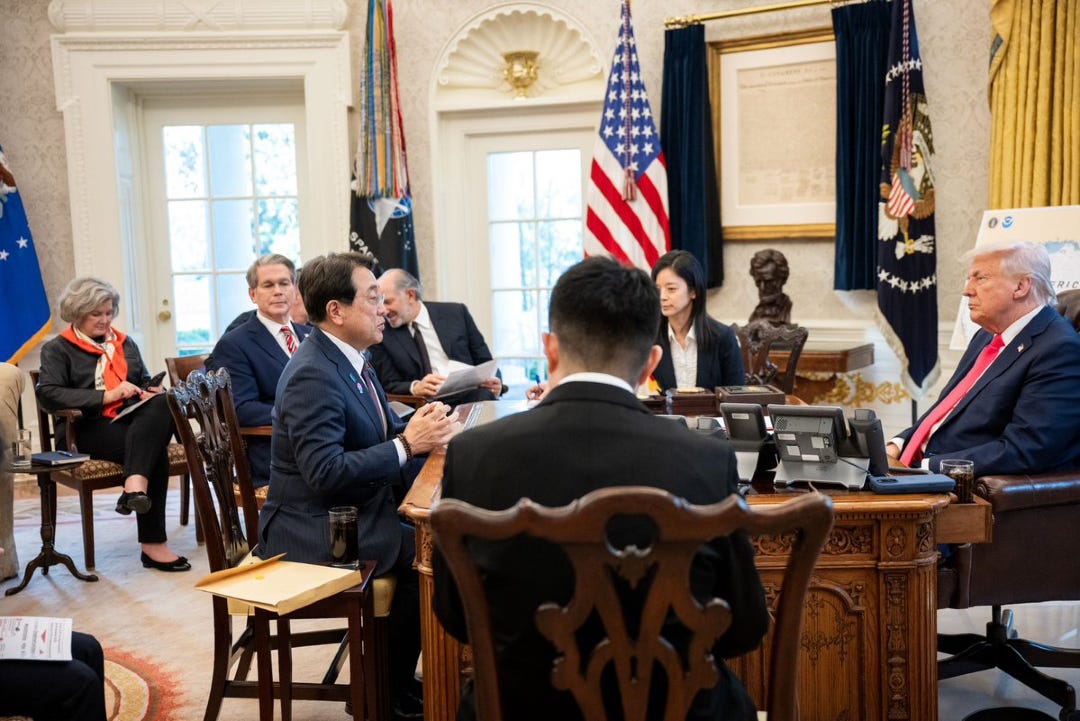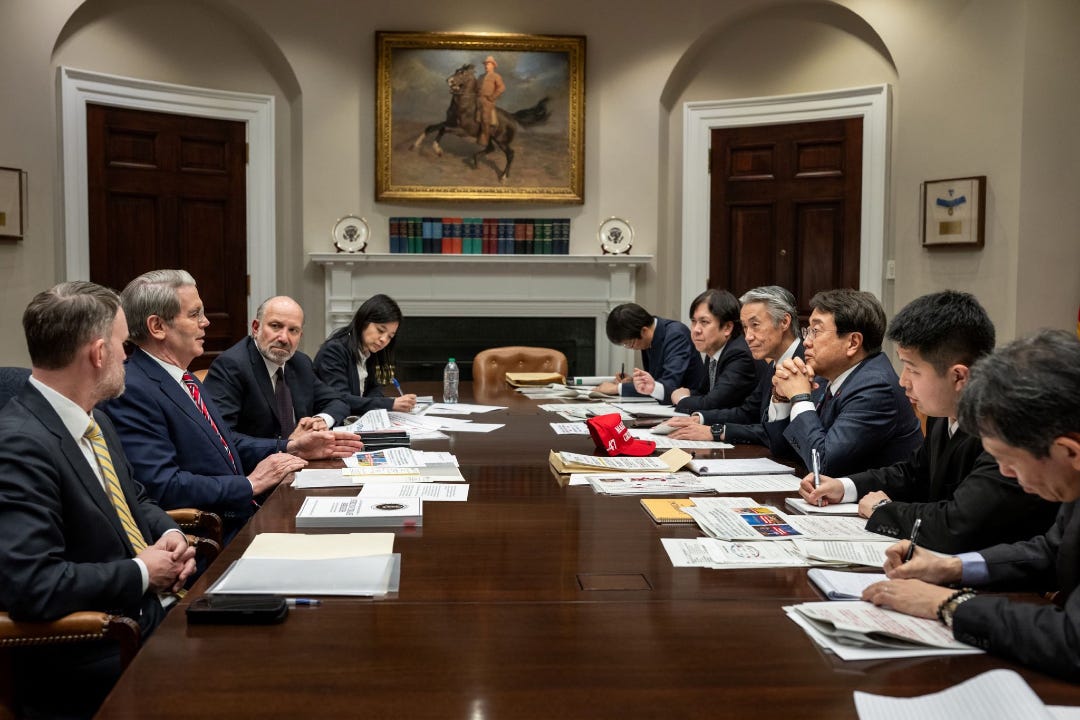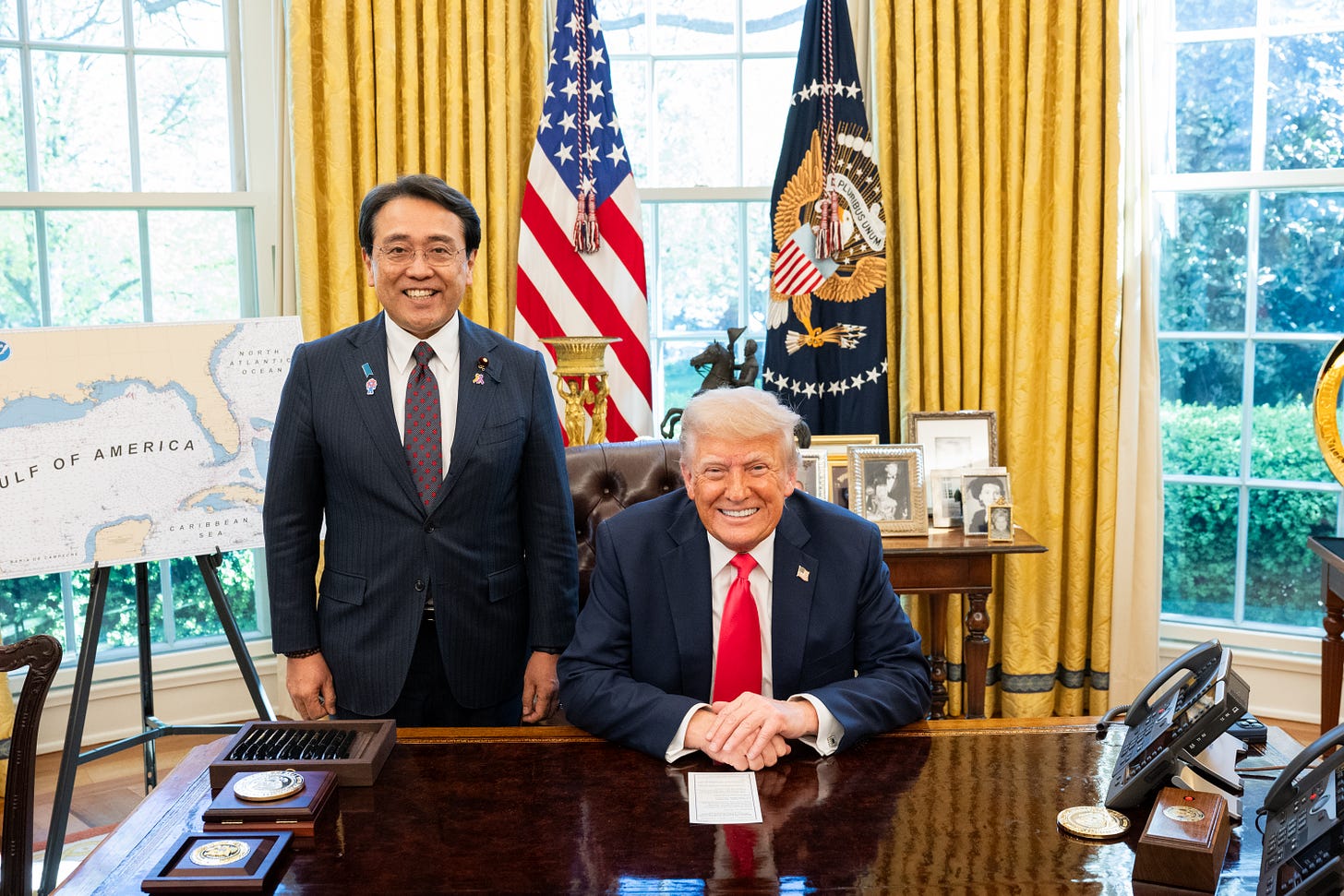Thank you for reading Observing Japan. This post is available to all readers.
If you are looking for timely, forward-looking analysis of the stories in Japans’s politics and policymaking that move markets, I have launched a new service through my business, Japan Foresight LLC. For more information about Japan Foresight’s services or for information on how to sign up for a trial or schedule a briefing, please visit our website or reach out to me.
I held a monthly conference call for paid subscribers on 16 April. Paid subscribers will be able to view the video, which will be posted soon.
I was quoted in a story in the Financial Times on Japan’s “guinea pig” trade talks with the United States.
I was interviewed by Kyodo News, which was published in a number of newspapers (here, behind paywall).

Akazawa Ryōsei, Prime Minister Ishiba Shigeru’s chief trade negotiator, got his first major test on Wednesday, 16 April when he found himself in talks not only with his US counterparts – Treasury Secretary Scott Bessent as well as Commerce Secretary Howard Lutnick and US Trade Representative Jamieson Greer – but with President Donald Trump, who said on social media while Akazawa was en route that he would meet with Akazawa himself. Within hours of his arrival, Akazawa was at the White House, first for a fifty-minute conversation with Trump and then for a separate seventy-five-minute discussion with his ministerial counterparts.
Neither government has revealed the specifics of what was discussed; Akazawa, in comments to the press following the meetings, said only that they agreed to pursue an agreement as quickly as possible, that he would have another ministerial meeting later this month, and that talks would continue at the ministerial and working levels. Both Akazawa and Ishiba said that talks were “tough” and “complicated” but “lively.”1
The Ishiba government went into the talks unsure of what exactly the Trump administration’s demands would be for the negotiations, in which it is seeking to avoid not only the 24% “reciprocal” tariffs suspended for ninety days, but also 25% tariffs on steel, aluminum, and automobiles. But, the Asahi Shimbun suggests, the talks are revolving around three pillars: (1) host-nation support for US forces in Japan, which Trump mentioned in his social media post announcing his participation; (2) US automobile exports to Japan; and (3) the US trade deficit with Japan.
This agenda looks like nothing so much as the “Mar-a-Lago accord” framework proposed by Stephen Miran, the chair of the Council of Economic Advisers, first in a paper published in November 2024 and re-articulated by Miran in remarks at the Hudson Institute earlier this month.
The essence of Miran’s proposal is that the United States should continue to provide global public goods but it should socialize the costs to its allies and partners, relieving the US of the costs of not one but two “exorbitant burdens,” the global reserve currency and global military dominance. As he writes:
The best outcome is one in which America continues to create global peace and prosperity and remain the reserve provider, and other countries not only participate in reaping the benefits, but they also participate in bearing the costs. By improving burden sharing, we can enhance resilience, and preserve the global security and trading systems for many decades into the future. (emphasis original)
He proceeds to outline how US negotiating partners can assume the costs of adjustment, including accepting higher tariffs without retaliation; opening their markets to US exports unilaterally; boosting defense spending and buying US-produced weaponry (and presumably paying more towards hosting US troops where applicable); investing in the United States; and “[writing] checks to Treasury” to pay for the costs of global public goods, perhaps by buying long-dated “perpetual” US treasuries. Another part of this framework may also include forcing members of the US-led bloc to decouple from China as part of the cost of membership, as suggested by the Wall Street Journal earlier this week.
Miran’s framework has been relentlessly dissected – I particularly enjoyed Adam Tooze’s take at Chartbook – but whatever the questions about the feasibility of this framework, it appears that this is precisely the blueprint that the Trump administration is using as it approaches trade negotiations with Japan followed by other trading partners. If Japan is a “guinea pig,” it is for the feasibility of the “Mar-a-Lago” approach in a series of bilateral talks with trading partners eager to avoid bearing the full brunt of Trump’s “reciprocal” tariffs.
Look again at the three pillars reported by Asahi and then again at Miran’s burden-sharing menu. In these talks, Japan is unlikely to secure the lifting of all tariffs (“accepting higher tariffs without retaliation”); face demands for greater market access for automobiles and perhaps also agricultural products (“opening their markets”); and pay more to host US forces in Japan. The Ishiba government, of course, is already looking for ways to supplement Japan’s world-leading foreign direct investment in the United States, another option on the menu. Also on the table could bilateral discussions between Bessent and Finance Minister Katō Katsunobu later this month with the goal of strengthening the yen against the dollar, though Akazawa said that exchange rates did not come up Wednesday. But on point after point, it sounds as if the Trump administration is seeking to press a “Mar-a-Lago”-style agreement as the price of some relief from its newly imposed tariffs.
It is understandable why the Trump administration is using Japan as a test case for its tariff negotiations. Not only has Japan not retaliated against the tariffs but, more importantly, its dependence on the United States for its security – with few alternatives in the near term – means that it may be an easier target for this approach than some other US negotiating partners. But just because Japan seems like a good fit for the Mar-a-Lago approach, these talks are a good illustration of a major reason for skepticism about this framework. Namely, the United States is not the only country with domestic politics. To secure the concessions desired by the United States, the Japanese government will have to grapple with its own domestic constituencies – farmers, government ministries, taxpayers – that may object to lowering trade barriers, changing domestic laws and regulations, or paying more for host-nation support when there is already an agreement in place that runs through March 2027. Even if it is possible to secure domestic support for these concessions, it could take time and could be more costly for Ishiba in light of both his weak political support and the approaching upper house elections.
But Ishiba’s problem is not only the substance of the agreement. There is also the optics. Ishiba has to sell an agreement to a public that is questioning whether the Trump administration can be trusted in light of its disregard for international trade law and, more importantly, may object to the very idea of Japan being treated as a vassal. It is unlikely to do Ishiba any favors to be seen as acting little more than than a vassal of the United States, paying tribute in order to secure protection. The Mainichi Shimbun quotes an unnamed senior economic policy official as describing negotiations on the basis of concessions to the United States as “tribute diplomacy.” “They just want to make Japan pay tribute as a template for future negotiations with other countries,” the official said. Opposition lawmakers, meanwhile, seeing that Akazawa thanked Trump for deigning to meet with a lower-ranked official, criticized him for abasing himself.

Speaking to the press after consulting with Akazawa, Ishiba said, perhaps with some understatement, “I have heard President Trump spoke frankly of his recognition of the current situation of the U.S. in the international economy.” This remark speaks volumes about how the Trump administration views its negotiations with Japan. The question now for Ishiba is whether there is room for a genuine negotiation that accommodates Japan’s national interests – which could enable a quicker agreement – or whether Ishiba is going to find himself in an increasingly impossible situation, trapped between a Trump administration determined to make its partners pay more and a public resentful of heavy-handed treatment by Japan’s longtime ally.







Excellent post.